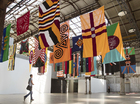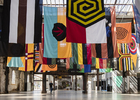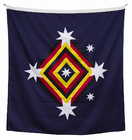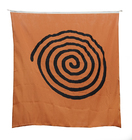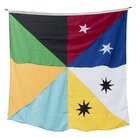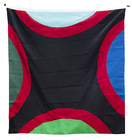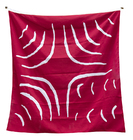Unedited email interview between Steve Dow and Archie Moore, January 2017
Steve Dow: Why is your work for The National spelled “United Neytions”?
Archie Moore: Relates to all the problems, bias, authenticity of data collected by R.H. Mathews (1841-1918). We know now there were many more nations than twenty-eight on the continent and its islands.
SD: I understand you have taken a map by a white, lay anthropologist by the name of R.H. Mathews, produced in 1900 on the eve of Australian Federation, which claimed to identify and map Aboriginal nations in mainland Australia. I understand this map identified only twenty-eight Aboriginal nations and was based on only limited field work and had these hard-and-fast contours. Was the map given much credibility by non-Indigenous Australians at the time it was produced?
AM: Good question. I haven't read any information that would answer this. Be interesting to know if many Aboriginal people had access to the publication at the time. This points to issues of authorship in non-Indigenous representations of Aboriginal people: the "white experts" who write black history. With this work I am more interested in the idea of authenticity, perceived racial superiority, lack of understanding and care etc. during the research stage. I adopted R.H. Mathews’ approach I believe - limited time to thoroughly research some of the national boundaries, when I have a creative block something close enough will suffice, overwhelmed with conflicting information - just choose any name for the area, delving into a field I have little experience and knowledge in.
SD: How and when did you first encounter the R.H. Mathews' map, and what was your initial response to it?
AM: I was asked by Fiona Foley to be involved in a show at the University of Queensland called "Courting Blakness" in 2014. Whilst surveying the outdoor exhibition area of the sandstone university's Great Court I noticed the line of lamp posts (modified flagpoles) that led to the Forgan Smith Tower which proudly flew five flags on its roof: the Australian National Flag, The Queensland University Flag, The Queensland State Flag, the Aboriginal and Torres Strait Islander flags with two flag poles reserved for if and when the Governor General visited. This got me thinking about nationalism and how aware were the students who laze on the grass at the base of this tower of the many nations that existed on this land many centuries ago. I did a bit of research and discovered Mr Mathews did a map and was the first non-Indigenous person to call these areas 'nations'. I designed and displayed ten of the fourteen Queensland Indigenous National flags according to Mathews’ map (academic whiteness and bureaucracy had intervened in flying these fictional flags next to the official ones on the tower).
SD: Despite its serious and obvious flaws, do you think R. H. Mathews had good intentions, or was he just another paternalist and coloniser?
AM: I had a fairly cursory look at who RH Mathews was so it is hard to say but he had the Biblical idea of what a nation was, that god had people demarcated along national lines rather than racial ones. Of course in his mind and others on the frontier there were two larger categories: civilised and uncivilised nations.
SD: So you have considered each of these Mathews-mapped nations, and taken flora and fauna from each of the areas identified, and created these twenty-eight bold and graphic flags. Some are square; others are up to 3.8 by 1.6 metres. How do you hope people respond to these, what I believe you call, false flags?
AM: Hopefully with a sense of the absurdity of nationalism. You see these "patriots" who carry five Australian National Flags with them or on their cars, who incorrectly state that their grandfather died under that flag at Gallipoli or such. There's a dissonance in their thinking - they think this is "the greatest place on Earth" while saying it's all being ruined by whatever group of people it is this time around. The flag they gaze at is of a bygone era when everything was much safer and true. I think this goes for Aboriginal Nationalists too and I can't imagine entirely embracing living like my ancestors did, it would be very difficult. Also, some of the flags are based on shield designs, as we didn't have flags but other symbols and signs to denote different groups or clans. There were conflicts between different groups, which is what happens within nationalism, my piece of land is better than yours etc. Reverence for patriotic symbols (the flag with the symbol of a colonial power) is becoming over-the-top but I do feel there's more legitimacy to Aboriginal symbols like body paint as it's directly connected to the land we're standing on.
SD: Are these flags intended to be ambiguous about what they convey, and what do these flags say about your own sense of cultural identity?
AM: I only wanted them to look like flags. I have looked at geographical features and unique customs or designs associated with each group. They feature dendro and petroglyphs, shield and body paint designs as well. My cultural identity is unverified and in a kind of limbo space or perhaps an ever-shifting identity. My ancestral history has been largely lost and it's hard to ascertain what it was.





